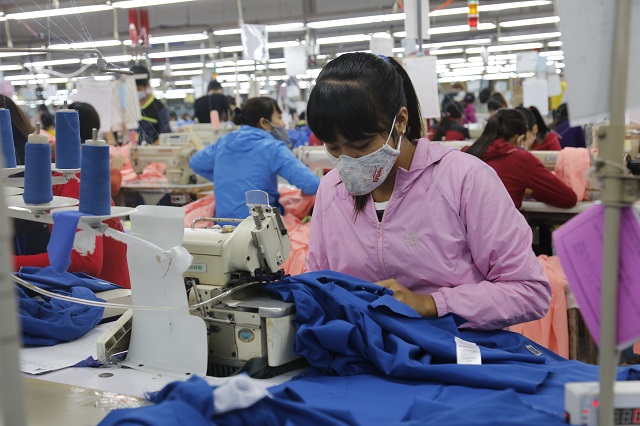
Revenues of Vietnam’s garment exports are set to average US$3 billion in the last two months of 2021, in turn putting the total figure to $38 billion for this year, or an increase of 8.1% year-on-year, according to the Vietnam Textile and Apparel Association (VITAS).
| Garment production at Nam Son Garment Company. Photo: Hai Linh |
For the past 10 months of 2021, the industry’s export turnover was estimated at $32 billion, up 10.8% year-on-year. Of the total, exports of fabrics and fibers reached an all-time high of nearly $4.5 billion, which is on track to attain $5.3 billion by late 2021, representing a sharp rise of 42%.
VITA's report also noted high revenue from geotextiles exports to major markets of Canada, the US, or India.
VITAS President Vu Duc Giang said the fourth Covid-19 outbreak and subsequent lockdowns in many provinces/cities have caused negative impacts on the domestic and global supply chains, especially as textile manufacturing plants were forced to suspend business activities or scale down operation to 20-40% of the full capacity in months.
However, the rate of worker reinstatement has been around 92-93% since restriction measures are gradually lifted, he added.
He said around 13-14% of the contract orders with deadline in the remainder of the year were shifted to other countries during the lockdown period, but there are positive signs that orders are returning in 2022 with economic activities back to normal.
“The local textile industry targets an export turnover of $43.5 billion in 2022,” he said but urged companies to catch up with changes in market behavior, especially in the US, or countries in CPTPP and EVFTA.
Giang also called for local textile firms to focus on complying with rules of origin to better take advantage of trade deals that Vietnam is a part of, adding this is essential not only for Vietnam to realize its export target but also to ensure sustainable development of the textile industry.
“A transparent production process would demonstrate a strong commitment of Vietnam’s textile producers to customers, brands, and also the environment,” he said.
Sharing the view, Chief Representative of the Cotton Council International in Vietnam Vo Manh Hung added the global textile and fashion industry is taking major steps towards environmental protection and sustainable growth.
Hung added cotton as key input material for the garment industry, should be produced in an environmentally-friendly process that helps alleviate the associated environmental and social costs, including the over-use of pesticides, the release of greenhouse gases, the depletion of local water sources, and rising costs of production.
“By 2025, the majority of global fashion brands have committed to sustainable cotton production, which requires local firms to shift to sustainable practices to avoid risks of losing competitiveness in the international market,” he added.






- Vietnam may prioritize economic growth over inflation control: PM
- Vietnam's exports at risks as US tariffs loom
- Vietnamese Gov’t plans to revise up 2025 GDP growth target to over 8%
- Number of green buildings in Vietnam doubles in 2024
- Vietnam prepares for potential global trade wars: PM
- Hanoi retail outlets open to keep prices stable during Tet

